Meanwhile, Rosenbluth had convinced the New York City Correction Department that his theory of using inmates as field workers could be applied in the case of young offenders.
He was given authority to establish New Hampton Farm, to be located just south of the town of Middletown, NY, as a unit of the New York City Reformatory Program.
The objective here would be to raise field crops, which could be used to feed inmates at the many other NYC penal institutions.
As before, Rosenbluth wanted EWB as his principal assistant, and convinced him to resign from the Clinton Prison job (which he did on March 1, 1914) and accompany Rosenbluth to New Hampton.
The New Hampton project was extremely successful, and EWB received an outstanding recommendation by NYC Department of Correction Commissioner Katharine Bement Davis when he resigned on March 31, 1915 after a little over one year at New Hampton.
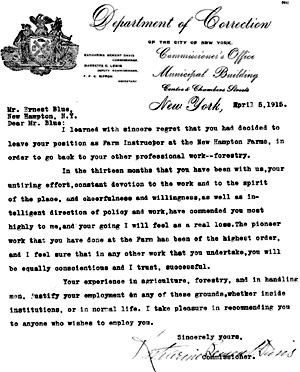 Letter from NYC DOC Commissioner Katharine Bement Davis to EWB on his departure. Click to enlarge. Use "back" button to return. Letter from NYC DOC Commissioner Katharine Bement Davis to EWB on his departure. Click to enlarge. Use "back" button to return. |
|
(I believe, but cannot prove, that EWB had agreed to give Rosenbluth only one year at New Hampton. He was anxious to get back to forestry.)
One time when I was about 14, my mother, dad and I were driving through the New Hampton area. We had just visited Douglas at West Point and were on our way to visit Malcolm at Cornell. We passed this huge complex of buildings. and father casually remarked that he had helped start that whole thing.
He also said, as I recall, that there was a plaque somewhere inside the main building with his name on it. Mother and I begged him to stop, but he didn't seem interested in doing so, so we didn't.
Ernest immediately returned to the tree planting business, taking on a job with the State at Lake Pond Camp near Paul Smiths, NY where he supervised the planting of one million trees on State land, with the job to be done by June first.
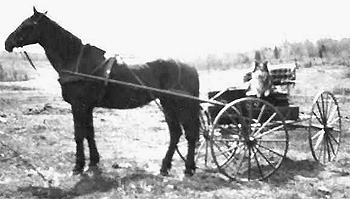 Horse and buggy and dog at New Hampton Farm. Horse and buggy and dog at New Hampton Farm. |
|
Records show that on April 29, 1915, he had a crew of 19 men on this job - including his young brother Frank who had been hired as the cook's helper. Apparently the men moved their camp several times to be near where the work was being done; for example it is known that on May 8th it was located near Slush Pond.
The job was successfully completed by the deadline of June 1, and on that date EWB was given a temporary appointment as NY State Conservation Department Forester at a salary of $1200/year. Just one month later, on July 1, 1915, he was again promoted, and on this occasion he wrote this short note to his bride-to-be:
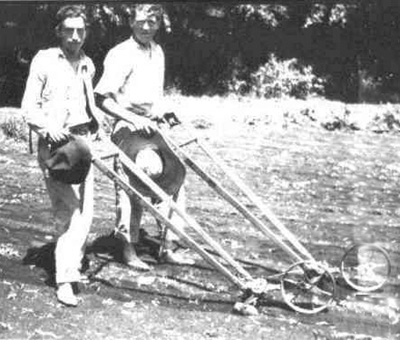 Bare feet in soft soil as inmates plow New Hampton Farm field. Bare feet in soft soil as inmates plow New Hampton Farm field. |
|
"Tonight I received a letter that has made me so very happy because it means the realization of many dreams - it is my appointment as Forestry Field Supervisor of the Conservation Commission. Are not our gods good?"
This position paid $1400 per year.
One of those many dreams may have been the possibility of marriage, for on the morning of April 15, 1916, EWB married Lulu B. Davis in Herkimer NY. They were married before noon because Ernest had to be at work the next morning at Lake Clear.
"Blue-boy" and "Lou-girl" (their names for each other at this point) boarded the 12:15 PM train for Saranac Lake. They had to ride in the baggage car until they reached Poland, but after that they had the front chairs in the Pullman "NADINE".
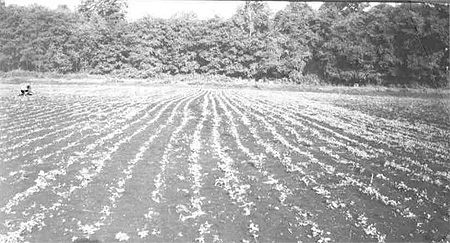 Lone picker (left) in New Hampton Farm field. Lone picker (left) in New Hampton Farm field. |
|
Lou-girl got her first look at the Adirondack Mountains as they journeyed north into the twilight. The next day she bought her wardrobe for the times to come. It included a pair of hob-nailed boots.
Their "honeymoon cottage" was a tent in the woods by a stream near Mt. Pond, as EWB continued to supervise tree planting around the area. Together they made a little dam on the stream. Ernest built a water wheel, which powered a discarded telephone hand crank mechanism to provide a single six-volt electric light. (All the comforts of home!)
They did not break this camp until October 12th, when tree planting ended for the winter. It had become awfully cold by that time.
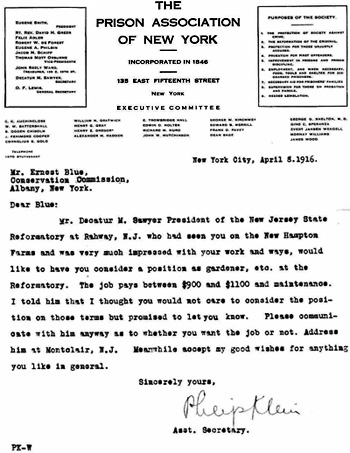 NY Prison Association conveys NJ Reformatory job offer to EWB. Click to enlarge. Use "back" button to return. NY Prison Association conveys NJ Reformatory job offer to EWB. Click to enlarge. Use "back" button to return. |
|
On September 1, 1917, Ernest was appointed District Forest Ranger of Region #3, which covered well over two million acres in and north of the Adirondack Park. (There were only five Districts in the entire State at that time.)
They moved to Old Forge on September 29, 1917 and to Poland on August 2, 1926. At Poland, they lived in the Sanders House until August 1, 1927, when they moved to a house near the center of town that was built by Chauncey Eddy in 1841. This is the house in which I was born.
Ernest retired on October 1, 1951. There was quite a problem with the computation of his New York State retirement, inasmuch as, initially, no records could be located for some of those very early years. Bob Rosenbluth was instrumental in seeing that Ernest got credit for all of his employment. Eventually, the missing records were uncovered. The correspondence regarding the retirement matter was the source of much of the employment information given above.
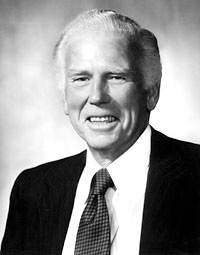 Perry B. Duryea was NYS Conservation Commissioner at the time EWB retired. Later Duryea served as Assemblyman and Assembly Speaker. Perry B. Duryea was NYS Conservation Commissioner at the time EWB retired. Later Duryea served as Assemblyman and Assembly Speaker. |
|
At the time he retired, Ernest was the longest-serving employee of the Conservation Department. He was especially cited by the Commissioner for his early work in forest fire control, which included the site selection and erection of fire towers throughout the Adirondacks.
My father also was responsible for the introduction of the Indian Pump into Conservation Department usage for fighting forest fires.
This pump, carried on one's back, was made by the D.B. Smith Company of Utica, originally for agricultural purposes.
Ernest recognized its fire fighting possibilities, and convinced both the Company and the State of this potential.
It soon became the standard weapon for use in the woods, and the State as well as private entities eventually placed thousands in service.
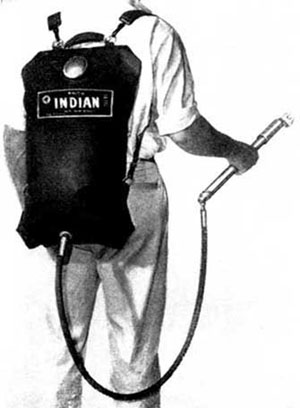 Indian Fire Pump manufactured by D.B. Smith Company of Utica. Indian Fire Pump manufactured by D.B. Smith Company of Utica. |
|
The Indian Fire Pump is still used today.
Lou died on September 14, 1963 after a series of strokes.
In 1964 Ernest married Lou's niece, Mildred P. Harter. His proposal to her was described as follows in a letter he wrote to Douglas and Allan on May 25, 1964:
"Yesterday...we visited Bernice and Chester Wells at Peter's Point and, returning via the beautiful woods road between Thayer's Corners and Woodins Corners, stopped for a serious talk in the course of which the lady said "yes". As we were about to leave I noticed we were parked close to a thrifty Beech tree and, on a sudden impulse, I got out my faithful axe and marked it with the long blaze and three hack marks used by the old Colonial surveyors to witness the corners of important land subdivisions."
His last trip into the woods he loved so well was on a crisp, sunny day in December of 1973 to cut a Christmas tree.
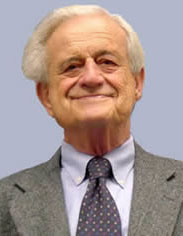 Dr. Marshall Rosenbluth Dr. Marshall Rosenbluth
1927 -- 2003. |
|
Ernest Wells Blue died on February 12, 1974.
The other son, Marshall Rosenbluth, became a noted theoretical mathematician in the US nuclear weapons program.
In the late 1950s, as an Atomic Energy Commission employee, I attended a meeting at Los Alamos where Dr. Rosenbluth was present. I had no idea at the time that we had other interests in common.

